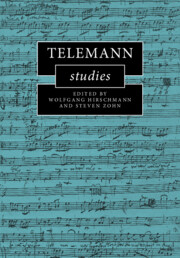Book contents
- Telemann Studies
- Cambridge Composer Studies
- Telemann Studies
- Copyright page
- Contents
- Figures
- Music Examples
- Tables
- Appendices
- Contributors
- Preface
- Abbreviations
- Part I Enlightenment Perspectives
- Part II Urban and Courtly Contexts
- Part III Nature (and) Theology in the Late Vocal Works
- 7 Telemann’s Donner-Ode and Lutheran Nature Theology
- 8 Body, Nature, and Emotion in Telemann’s Christmas Cantatas
- 9 Beyond Simplicity
- Part IV Bach Family Connections
- Part V Cantata Cycles in Frankfurt, Hamburg, and Beyond
- Index of Telemann’s Works
- General Index
8 - Body, Nature, and Emotion in Telemann’s Christmas Cantatas
from Part III - Nature (and) Theology in the Late Vocal Works
Published online by Cambridge University Press: 14 July 2022
- Telemann Studies
- Cambridge Composer Studies
- Telemann Studies
- Copyright page
- Contents
- Figures
- Music Examples
- Tables
- Appendices
- Contributors
- Preface
- Abbreviations
- Part I Enlightenment Perspectives
- Part II Urban and Courtly Contexts
- Part III Nature (and) Theology in the Late Vocal Works
- 7 Telemann’s Donner-Ode and Lutheran Nature Theology
- 8 Body, Nature, and Emotion in Telemann’s Christmas Cantatas
- 9 Beyond Simplicity
- Part IV Bach Family Connections
- Part V Cantata Cycles in Frankfurt, Hamburg, and Beyond
- Index of Telemann’s Works
- General Index
Summary
Telemann’s numerous compositions for the Christmas season reflect important changes in the understanding and celebration of the feast day throughout his prolific career. The early Christmas cantatas are influenced by an understanding of the feast that combined Lutheran mysticism with a language emphasizing the personal relationship between Christ and the believer through the physical/corporeal as well as emotional concepts: love, heart, desire, and so on. Telemann transferred this language to musical compositions featuring highly emotional melodic lines, often employing musical topi (such as sigh figures) that were familiar from pietist songs and operatic love arias. In his later works, especially in the cantata Die Hirten bei der Krippe to a text by Ramler, the focus shifts from personal emotionality to a divine encounter in nature. The pastoral sphere, influenced by the physico-theology of the time, replaces love arias from the earlier works. This chapter traces developments both in Telemann’s music and in theological discourse around the middle of the eighteenth century. It is not the understanding of Christmas that changes but rather the communicative function of emotion and affect both transforms and shifts throughout Telemann’s lifetime.
Keywords
- Type
- Chapter
- Information
- Telemann Studies , pp. 179 - 198Publisher: Cambridge University PressPrint publication year: 2022

